The 2011 MacBook Air (11 & 13-inch): Thoroughly Reviewed
by Anand Lal Shimpi on July 28, 2011 3:25 AM EST- Posted in
- Apple
- Mac
- Intel
- Sandy Bridge
- MacBook Air
- Laptops
CPU Performance: A Huge Upgrade
I've got an expanded test suite here courtesy of the testing I did for our Lion review. As I mentioned in our Lion review, performance hasn't changed between Snow Leopard and Lion for the most part so the older data in these benchmarks is still quite valid.
Adobe Photoshop CS4
The old Air was not very good for those doing a lot of photo work. You could manage, and I definitely did, but it was painful. The story is completely different with the new MacBook Air however.
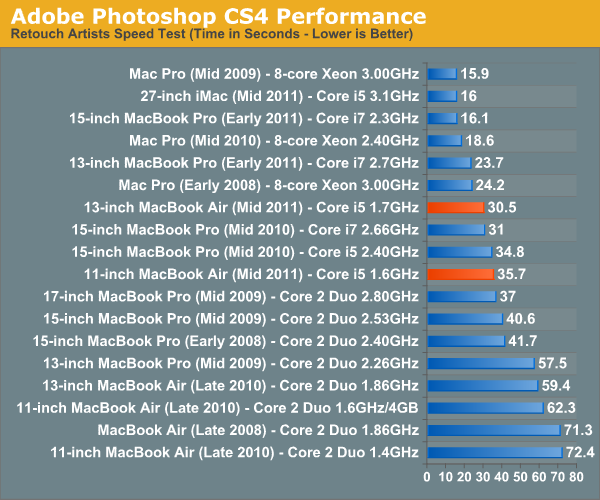
While the 2011 Macbook Pro is still considerably faster, completing our CS4 test in just over half the time as the 13-inch Air, these machines are competitive with last year's MBP. Remember the 2010 MacBook Pro only had two Arrandale cores and these Airs have lower clocked, but higher performing Sandy Bridge cores. Part of the performance advantage is the integrated SSD, whereas those older Macs didn't come with one by default. But most of the time these chips are running near their max turbo frequencies under load, which really helps narrow the performance gap between them and their 2010 professional counterparts.
If you have anything older than a 2010 MacBook Pro, these new Airs will actually be an upgrade for you.
Cinebench: Single & Multithreaded Performance
The old Air just wasn't that great of a performer. They were good enough if you didn't do much with your machine, but for those who lived on the bleeding edge they performed like a 3 year old MacBook Pro.
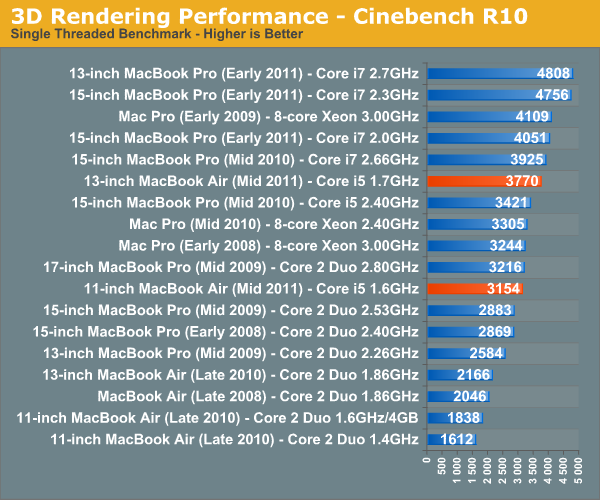
Single threaded performance on the new Air is much better than before thanks to turbo boost. The 11-inch MBA is 71% faster than the upgraded 11 from last year, that's more than noticeable in real world usage. The 13-inch MacBook Air enjoys a similar advantage over its predecessor.

Where things get even more ridiculous is in multithreaded performance:
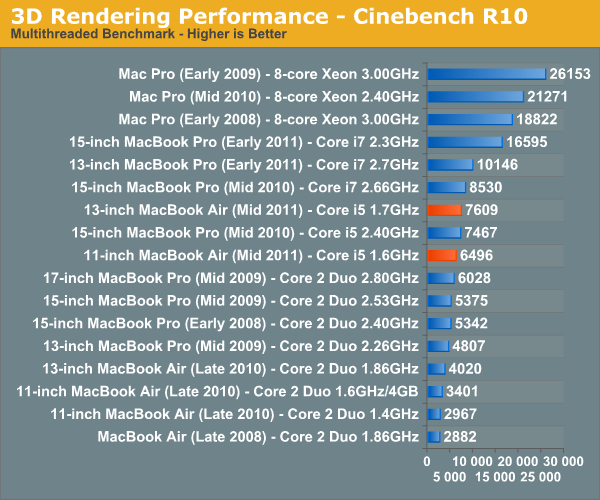
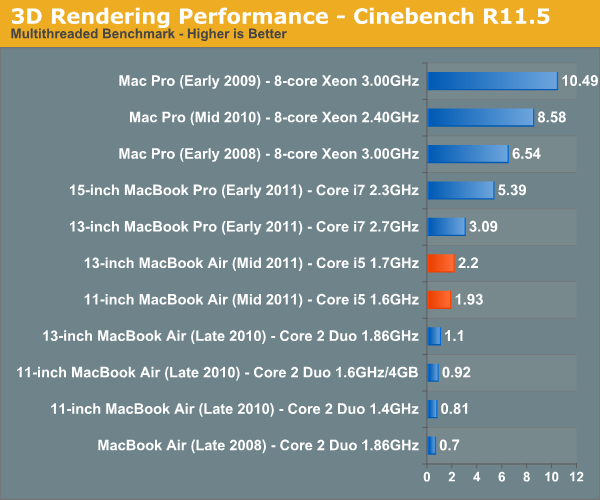
The single threaded performance of the new 11-inch MacBook Air is actually higher than the multithread performance of last year's model. Thanks to Hyper Threading and better performance per core you get around twice the performance of last year's models. Again the Air still isn't as good as the new quad-core MacBook Pros, but if you've got a machine from 2008 the new 13-inch MBA will actually be a performance upgrade (and a more portable machine).
Boot Performance
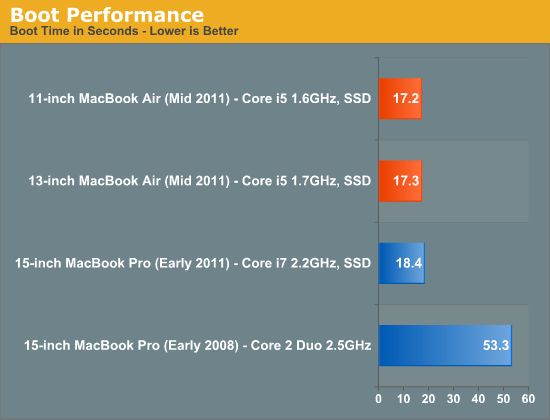
Boot time on these machines is great thanks to Apple's minimalist EFI and their SSDs. I will mention that the MacBook Air used to wake from sleep almost instantly however as of several OS revisions ago there seems to be a noticeable lag before I get a usable mouse cursor. I don't remember this being the case when the MacBook Air first came out and it's no different in Lion.
iMovie 11 Performance
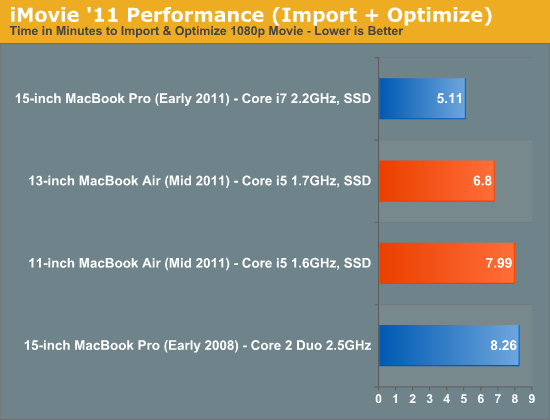
If you're going to be doing any video transcoding work you're going to want to upgrade the 11-inch MacBook Air's CPU. While it's much quicker than it used to be, the 1.6GHz Core i5 takes 17% longer to finish our iMovie import script than the 1.7GHz i5 in the 13-inch MacBook Air.
Exporting is a far bigger issue on these parts. Again the new systems are much faster than the old ones but if you're serious about video transcoding you should probably have a MacBook Pro.
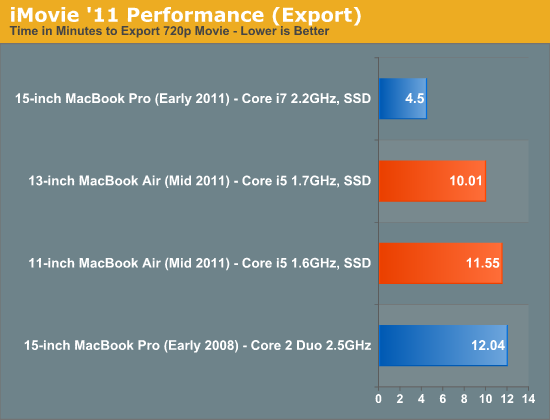
I'd also like to take this opportunity to say that it's absolutely ridiculous that Apple still doesn't support QuickSync in iMovie. We'd see far better performance from all Sandy Bridge equipped Macs if Apple would just take advantage of QuickSync. The silicon is there, it just needs to be used.
iPhoto 12MP RAW Import
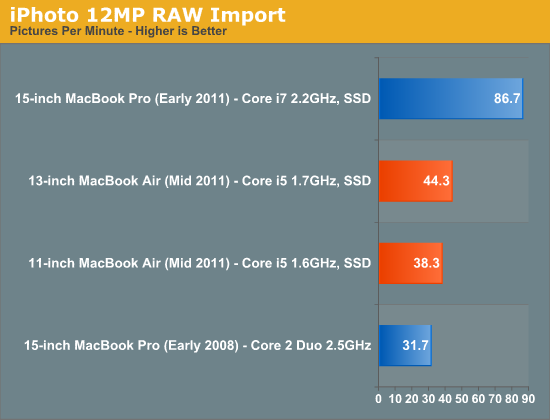
Here the new Airs do very well, but the 15-inch MacBook Pro is still around 2x the speed.
Adobe Lightroom 3
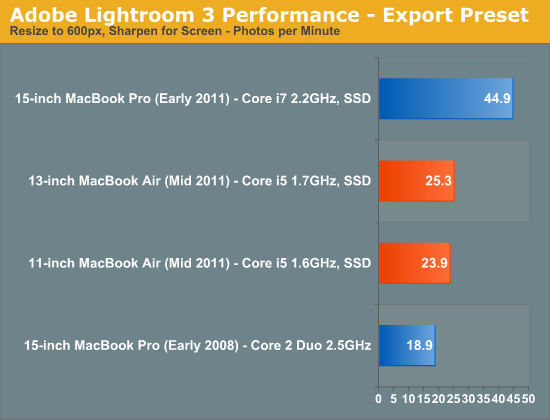
Final Cut Pro X
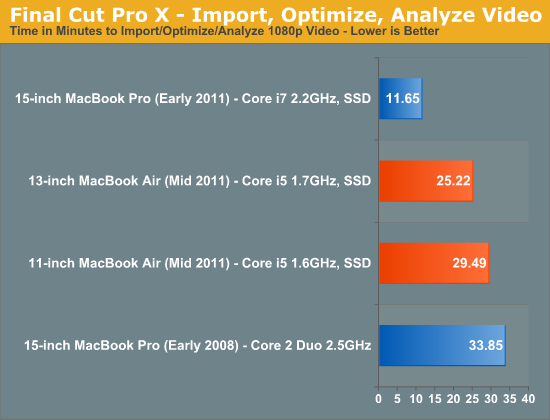
The trend continues. These new machines are faster than a 15-inch MacBook Pro from early 2008, but are no match for the new 2011 15-inch MacBook Pro. If you're going to do a lot of video encoding there's no replacement for more cores.










103 Comments
View All Comments
name99 - Thursday, July 28, 2011 - link
"The WLAN solution in the Air is capable of up to two simultaneous spatial streams, topping out at 270Mbps.
In practice this results in peak performance over 802.11n at around 128.8Mbps.
"
This is a horribly misleading way of stating the issue. It implies that Apple or the chipset or something are somehow defective, in only delivering 50% of the available performance.
The ACTUAL problem is the 802.11 MAC & protocol, which wastes about 50% of the available bandwidth doing god knows what. The packets that go out, go out at of order 270Mbps, but 50% of the time packets are not going out.
This would be a good topic for a future AnandTech article --- just what the hell is the 802.11 MAC doing that wastes so much airtime?
A useful issue to discuss in the same article is the following:
I read once that there was an advanced option in the 802.11n MAC that reduced this wasted time to only (hah!) about 25%, but I have never seen details on this (and I have looked). Is it real? If it is real, does anyone support it?
ninjaquick - Thursday, July 28, 2011 - link
The relevance of SSDs is really only synthetics and low ram high cache situations. I do like seeing these get beat out squarely by an i3 in pretty much everything else in the win7 tests.bji - Friday, July 29, 2011 - link
How do you draw that conclusion about SSDs?KPOM - Friday, July 29, 2011 - link
They only get beaten out by the i3 in the 3D tests, which are driven by the GPU, so it's more fair to say that the HD 3000 gets beaten out by a discrete graphics adapter, which is no surprise. The Airs handily beat out the i3 in the CPU-intensive benchmarks.I've used an SSD since November 2008 and won't go back. I still need to use a HDD-equipped machine at the office, and I can't stand how long it takes to restart, shut down, or do anything disk intensive. The SSD made the Core 2 Duo-equipped MacBook Air tolerable in a world of i3s, i5s, and i7s. The Sandy Bridge-equipped MacBook Air with SSD makes it that much better.
Baron_Fel - Thursday, July 28, 2011 - link
When are you guys going to review the new Vaio Z? I want to know if that external GPU is worth anything.TwoStreetCats - Thursday, July 28, 2011 - link
I'm a very happy owner of the 2010 11" version and have to say that the form factor was the primary draw for me as I travel quite a bit. It fits quite nicely in the hydration pocket of my backpack and I hardly know that I have it with me.The only thing that is occasionally frustrating is the vertical resolution as the article mentions.
However, I use Mac Screen Rotate to rotate the screen and touchpad for portrait viewing when browsing or viewing pdf's and this problem is solved. If size and weight are serious factors for you, I highly recommend trying this out with the 11" before you decide that you need the 13".
www.macscreenrotate.com
bji - Friday, July 29, 2011 - link
If the TDP of the processor + graphics is 17W, why does the Macbook Air even need a fan?My Panasonic Y2, which I still use because I can't find a laptop I like better (just sold a Sager NP5160 that I only owned for 2 months because I couldn't stand the fan noise or the horrible keyboard), has a 22 W max TDP on just the Pentium M 1.4 Ghz processor. Probably the crummy Intel integrated graphics doesn't add more than a few watts but together they must be at least 25 W.
And yet, the Macbook Air, with a 17 W processor + graphics combined, has a fan. There is plenty of aluminum in the body of the Macbook Air to act as a heatsink, why does Apple even need to put a fan in there? If the Y2 can go fanless, surely the Air can.
bji - Friday, July 29, 2011 - link
OK, turns out the Pentium M in my Panasonic Y2 is the 10 watt Pentium M 738, not the 22 watt Banias Pentium M.The Intel 855 GME chipset is listed at 3.2 W.
Is it really the case that 10 W can be fanless but 17 W cannot?
tipoo - Friday, July 29, 2011 - link
Might be possible in 17w, but it already gets pretty hot WITH a fan.hellknight - Friday, July 29, 2011 - link
I couldn't believe that Intel included AES instruction set in such low voltage chips. Even the base model has those.. This is something very great.. It would be great for all Truecrypt users..